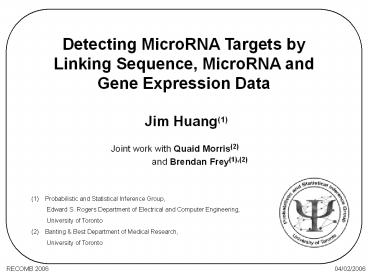Detecting MicroRNA Targets by Linking Sequence, MicroRNA and Gene Expression Data - PowerPoint PPT Presentation
Title:
Detecting MicroRNA Targets by Linking Sequence, MicroRNA and Gene Expression Data
Description:
Title: Detecting MicroRNA Targets by Linking Sequence, MIcroRNA and Gene Expression Data Author: Jim Last modified by: Jim Huang Created Date: 8/11/2004 1:21:21 PM – PowerPoint PPT presentation
Number of Views:242
Avg rating:3.0/5.0
Title: Detecting MicroRNA Targets by Linking Sequence, MicroRNA and Gene Expression Data
1
Detecting MicroRNA Targets by Linking Sequence,
MicroRNA and Gene Expression Data
Jim Huang(1)
- Joint work with Quaid Morris(2)
- and Brendan Frey(1),(2)
- Probabilistic and Statistical Inference Group,
- Edward S. Rogers Department of
Electrical and Computer Engineering, - University of Toronto
- Banting Best Department of Medical Research,
- University of Toronto
2
Transcriptional regulation
3
Post-transcriptional regulation
4
Finding microRNA targets
- Lots of targets are they all real?
- IDEA Use high-throughput data to find bona fide
targets
5
Mechanisms for microRNA regulation
- Post-transcriptional degradation of target mRNA
transcript - microRNA triggers the destruction of target
- Translational repression
- microRNA prevents translation to protein
6
Mechanisms for microRNA regulation
- Toronto microRNA, mRNA and protein data
- TargetScanS microRNA target predictions
Combine
7
Linking microRNA and mRNA expression
- 1,770 TargetScanS candidate targets linking 788
targeted mRNA transcripts to 22 microRNAs in 17
tissues
p lt 10-7
8
Generative model for microRNA regulation
mRNA sequence data
GCATCAT AACTGCA
Get candidate targets
microRNA sequence data
mRNA expression data
microRNA expression data
Detected microRNA targets
9
The GenMiR method
- Observed
- Set of candidate microRNA targets
- microRNA expression data
- mRNA expression data
- Unobserved
- Indicator variables
- Model parameters
- Regulatory weight for each microRNA
- Background level of mRNA expression
10
Some notation
11
A Bayesian network for detecting microRNA targets
tissues t 1,,T
messenger RNAs g 1,,G
microRNAs k 1,,K
Indicator of putative interaction between
microRNA k and target transcript g
cgk
microRNA expression level
Indicator variable for whether microRNA k truly
targets transcript g
sgk
zkt
Target transcript expression level
xgt
12
A probabilistic model for microRNA regulation
tissues t 1,,T
messenger RNAs g 1,,G
microRNAs k 1,,K
Indicator of putative interaction between
microRNA k and target transcript g
cgk
microRNA expression level
Indicator variable for whether microRNA k truly
targets transcript g
sgk
zkt
Target transcript expression level
xgt
13
A probabilistic model for microRNA regulation
Indicator of putative interaction between
microRNA k and target transcript g
cgk
Targeting probabilities
Indicator variable for whether microRNA k truly
targets transcript g
sgk
14
A probabilistic model for microRNA regulation
tissues t 1,,T
messenger RNAs g 1,,G
microRNAs k 1,,K
Indicator of putative interaction between
microRNA k and target transcript g
cgk
microRNA expression level
Indicator variable for whether microRNA k truly
targets transcript g
sgk
zkt
Target transcript expression level
xgt
15
A probabilistic model for microRNA regulation
Probability of data given targeting interaction
microRNA expression level
Indicator variable for whether microRNA k truly
targets transcript g
sgk
zkt
Target transcript expression level
xgt
16
A probabilistic model for microRNA regulation
Targeting probabilities
Probability of data given targeting interaction
Joint probability
17
Learning microRNA targets
- Maximize likelihood of observed data
- Upper bound on negative log likelihood
GOAL Optimize fit of model to data
18
Variational Inference
- Exact inference
- Posterior is intractable to compute!
- Approximate the posterior distribution
19
Detecting microRNA targets
20
Detecting microRNA targets
LESSONS 1) We CAN learn from expression and
sequence data! 2) Combinatorics are critical for
learning targets!
21
Summary
- Evidence that microRNAs operate by degrading
target mRNAs - Model for combinatorial microRNA regulation
- High-throughput method for learning bona fide
miRNA targets - Full list of detected microRNA targets is
available at www.psi.toronto.edu/GenMiR/
22
The road ahead
- Differences in normalization and hybridization
conditions in mRNA and microRNA data? - Bayesian learning
- Robustness of model and learning algorithm to
- Subsampling of data?
- Introducing fake targets?
- Biological verification and network mining
J.C. Huang, Q.D. Morris and B.J. Frey. Bayesian
Learning of MicroRNA Targets from Sequence and
Expression Data (submitted for publication)
23
Sufficient statistics
24
Variational Expectation-Maximization
Variational E-step
Variational M-step
GOAL Optimize fit of model to data and look at
?gks
25
Variational EM updates
Variational E-step
Variational M-step
26
Combinatorial microRNA regulation
27
Robustness of the GenMiR model

